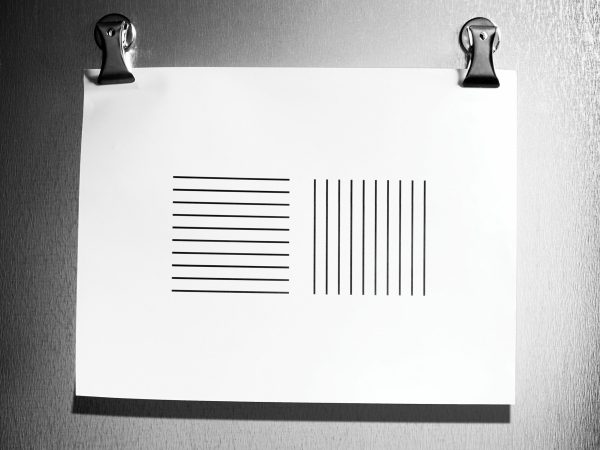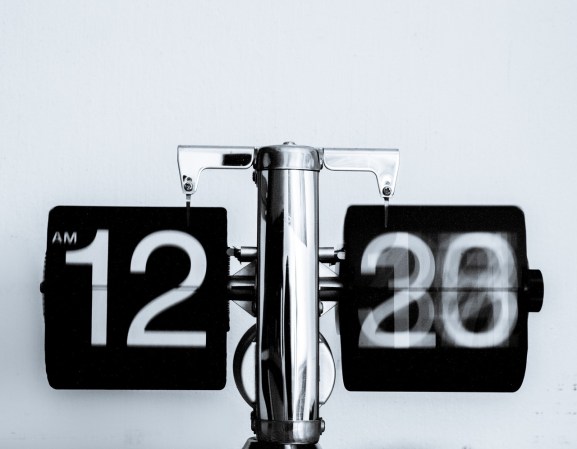

Most people probably haven’t visited an auction house, but they are, perhaps surprisingly, rather accommodating of the masses. Last fall, I visited Sotheby’s New York offices, a gray and glass building near the East River. In the foyer, between a high-security prison for collectible wines and the concierge’s desk, someone had parked Richard Feynman’s Dodge Tradesman Maxivan.
At the time, the internationally-renowned art dealership was preparing for its second annual science and technology auction, which would include a significant number of pieces from the late physicist’s personal collection. Brown like day-old guacamole, the van was a promotional poster for quantum mechanics. He’d had the central panel on the left, right, and back of the vehicle covered in supersized “Feynman diagrams”—rune-like squiggles that revolutionized our conception of the behavior of subatomic particles. It was not for sale, but Feynman’s private papers, artistic sketches, and 1965 Nobel Prize for his work in quantum electrodynamics, or Q.E.D, certainly were. Sotheby’s staff estimated the golden Nobel would go for more than $800,000.
On the exhibition floors above, I found a few people—potential buyers or, just as likely, the representatives they selected to preserve their anonymity—milling about the spacious, stark white rooms. Apollo 11 flight plans, an X-ray of Neil Armstrong’s reinforced marshmallow boots, and “flown” dehydrated pot roast sat on little podiums, awaiting new homes. As I descended an escalator, a trio of moon suits greeted me, suspended from the ceiling like million-dollar sacks of flour. Two were from the Soviet Union. The one from NASA’s Project Gemini had a giant zip-down crotch; presumably, in 1961, the physics of low-gravity urination were a puzzle yet to be solved.
In still other galleries, models of rovers and landers hung from the ceiling or sat on shelves illuminated with purplish strips of LED lights. The displays were reminiscent of a museum gift shop, which, in a way, this was. At Sotheby’s, almost everything can be touched, provided you ask for assistance and, if necessary, don the appropriate gloves. More importantly, everything is for sale.

Auctioneers have commanded crowds for thousands of years. But it wasn’t until the Georgian era that auctions became sophisticated affairs; Sotheby’s opened in 1744 and Christie’s, its close competitor, followed in 1766. While the Greeks and Romans sold wives, slaves, and the spoils of war, modern buyers gobbled up goods endowed with historic significance—and emotional consequence. In the 1800s, buyers were battling over dead queen’s dresses; today, Zsa Zsa Gabor’s pill bottles are just as likely to start a bidding war.
Celebrity science auctions sit at the center of this lucrative Venn diagram, between erudite acquisition and outright glamour. Unlike most physicists who toil in obscurity, Feynman carefully crafted a public image for himself, primarily through two rather depraved bestselling memoirs, Surely You’re Joking, Mr. Feynman! and What Do You Care What Other People Think? Like Stephen Hawking, whose wheelchair, Simpsons script, and graduate thesis were auctioned off by Christie’s in 2018, Feynman’s interlocking legacies created a wide range of potential buyers. Some people want the technical material, such as the handwritten computations from his time in the Manhattan Project. Others want a piece of their hero’s personality: a scalloped placemat from a defunct Pasadena, California strip club Feynman once did some math on sold for $162,000.
“At auction, we sell the story of the object,” says Cassandra Hatton, Sotheby’s vice president for books and manuscripts and the organizer of the science and technology auction. “Most of what we sell has no inherent value, when you really think about it.” A fully-operational Enigma machine, which the Germans used to decipher codes, is worth $200,000 to a collector, but aren’t the incredible cryptography tools they were in pre-computer days. Nobels minted before 1980 are 175 grams of solid 23 karat gold, or about $7,500 worth of precious metals. But the prizes—even the more recent 18 karat recycled gold medals—end up selling for much more.
Some buyers want to collect a Nobel in every category (physics, medicine, and so on), or because they love a specific winner, “or because they want to be able to brag,” says Hatton, who keeps a spreadsheet of every Nobel sale ever recorded. Over time, she’s seen a pattern emerge: the easier the prize-winning discovery is to describe, the higher its selling price. “If you’re bragging to a group of friends, you want to have something that’s really easy to explain,” Hatton says. James Watson’s 1962 Nobel sold for a record-setting $4.1 million. His discovery can be summed up in just three letters: D.N.A.

Sotheby’s specialists go to great pains to verify the authenticity of its wares. Hatton began her career in a rare books dealer’s shop in Los Angeles. “My boss just told me, ‘Just organize these papers,’” she says. “They were all in German and mathematical and I didn’t really know what they were.” Later, she learned they were Einstein’s notes on unified field theory. “I thought, ‘Oh my god! Why didn’t you tell me beforehand?’” Hatton went on to attend rare book seminars and even earned her Master’s in the history of science, but she still maintains the best learning is on the job. “You just have to handle a lot of material,” she says.
Though the hunt often begins with a promising picture, sent in by a prospective seller, specialists must make the judgment call in person. “There are certain tells that the object will have,” she says. With books, the wrong swirl in a signature or a warped watermark under the light are common clues. “I know it sounds funny, but you can smell if a book is wrong,” she says. “You can smell if there’s been some kind of repair or restoration… because of the different types of chemicals or glues.” For space suits, authentic Apollo gear was made of beta cloth—a fireproof silica fiber—while movie props are nylon. Hatton can tell the difference by touch alone.
Sotheby’s is also responsible for clearing the legal rights of sale for every object that passes under the auctioneer’s hammer. That presents a number of challenges, especially for relics of space exploration. Before 2012, there were no laws clarifying the ownership of objects that the United States flew in space. “Astronauts had these things called a personal preference kit—PPK,” Hatton says, typically rings, flags, and medallions. “Those were clearly theirs.” But everything else was a big question mark caked in moon dust. When Ed Mitchell, the sixth man on the moon, tried to auction off a camera he’d saved from the wreckage of the lunar lander, NASA sued him. This eventually prompted an act of Congress clarifying what belonged to astronauts—and what didn’t. Small and expendable objects like flight plans were cleared; moon rocks or landers, not so much.
Of course, those rules don’t apply everywhere. Before they even made it to the auction block, someone purchased three moon rocks, the only privately-owned sample on Earth, for $855,000. The minuscule shards, preserved in a rectangular metal case with a magnifying lens attached, had been gifted by the USSR to Nina Ivanovna Koroleva, the widow of the nation’s space program director. This was, Sotheby’s wrote at the time, a rare case of “an actual piece of another world [being] offered for public sale.”

There are myriad reasons for buying—and selling—such artifacts. It can be cathartic: In 2018, Australian actor Russell Crowe held a “divorce auction.” (Comedian John Oliver reportedly purchased Crowe’s jockstrap from the movie Cinderella Man.) It can be cruel, as many claimed when the children of the late Princess Margaret auctioned off, among other things, the tiara their mother wore to her wedding. It can also be painfully pragmatic: In 2015, Leon Lederman sold his 1988 Nobel Prize in physics to pay for his mounting medical bills. But whatever the motivation, it’s often a missed opportunity for museums and archives, many of which survive on donations alone.
“As a museum curator, ideally, you’d like to see things that are of great significance in public collections where the great majority of people can see them,” says Peter Jakab, chief curator of the Smithsonian National Air and Space Museum. “In our modern world of online auctions that are readily accessible to people, people do like to sell their artifacts rather than donate them,” he adds, saying in his 35 years at the Smithsonian “there’s definitely been a culture shift.”
Here, the fate of Einstein’s so-called “God Letter” is particularly illustrative. In 1954, the physicist wrote to Eric Gutkind, a German philosopher who’d recently published the book Choose Life. The resulting missive is a testament to Einstein’s struggle with religious belief: “For me the unadulterated Jewish religion is, like all other religions, an incarnation of primitive superstition,” he wrote. “And the Jewish people to whom I gladly belong, and in whose mentality I feel profoundly anchored, still for me does not have any different kind of dignity from all other peoples.”
For decades, the letter appears to have been in the possession of Gutkind’s close friend Henry Leroy Finch, says Christie’s specialist Peter Klarnet. In 2008, the letter resurfaced at Bloomsbury Auctions, which subsequently sold it for $404,000 to an anonymous buyer who reportedly outbid Richard Dawkins. In 2012, it was listed on eBay, but didn’t sell. Finally, in 2018, Christie’s announced it would again bring the letter to auction—with a twist.
For years, there circulated a translation of the letter in which Einstein called the Bible “pretty childish.” But Klarnet, who reads a bit of German, found no trace of the word “kindisch” in the original text. (The Harmonia Philosophica blog was the first to note the omission back in 2012, after photographs of the document were posted as part of the eBay sale.) Klarnet sent the letter to a Christie’s specialist in London for a “very, very careful painstaking analysis,” which concluded Einstein hadn’t used the word at all. “We’re still not 100 percent sure where that comes from,” Klarnet says of the embellishment. “It was either someone trying to sensationalize, or taking artistic license,” he later added. Had it not been for these brief moments when the document was about to change private hands, the public might still be in the dark.
Christie’s subsequently sold the God Letter for $2,892,500.


That’s not to say collecting is unethical. It’s just tricky. For one, “not everything is the Mona Lisa,” Jakab says. So long as they’re properly preserved—kept in a humidity-controlled environment, say, or handled with gloves—”mundane” or “garden variety” historical objects should be fair game. In some cases, collectors become experts in their area of interest, and collaborate with curators in the same field. “I can assure you, people with private collections love to talk about them,” Jakab jokes. Most importantly, private owners can share their objects with the public in different ways. “When you, say, put an airplane in a museum, it’s not going to fly again,” Jakab says. “But if you had a historical example that’s in private collection… you could hear the motor, see how it flies, and there’s great value in that as well.” Jakab himself is a collector of antique cars. “As we say, you don’t own the car, you just maintain it until the next person has it after you.”
Still, museums, archives, and rare books libraries do their best to grab the things that matter, whether it’s through acquisition, soliciting donations, or orchestrating loans. Peter Collopy is an archivist at the California Institute of Technology, where Feynman spent almost 40 years teaching, doodling, researching, and driving around in his custom-painted van. Over the years, the physicist, and later his widow, gave countless pieces of fan mail, academic notes, and videotapes to the university. Today, Caltech’s Feynman archive totals 92 boxes of material. Removed from their cardboard enclosures and stacked one on top of the other, the combined papers and videotapes would stretch 38 feet high.
Even so, Collopy wants more. Feynman’s lecture notes, reams of calculus, and correspondence with other prominent scientists are useful “for a historian or physicist who wants to understand Feynman beyond the published record,” Collopy says. That means the archive must be stocked with relevant materials—with mysterious materials. An archivist’s central duty is to preserve, but they’re also stewards of the electric idea that there’s always more to discover.
It’s not all enchanting. “There are some documents, like receipts from someone’s lunch, that might not be of interest,” Collopy says. “You can never say they won’t be, but you can make an educated guess.” Other objects, like Caltech’s existing collection of Nobels, may seem glamorous, but in reality, don’t yield new scholarly insights and ultimately pose a security risk. Some museums, like the Smithsonian, have a process for “deaccessioning” objects—clearing out objects that no longer meet its “collections rationale” and placing them with other institutions. It may sound like the Island of Misfit Museum Objects, but it helps curators around the world clear space, and acquire new artifacts.
At the Caltech archive, “virtually everything” comes through donation, Collopy says. Feynman donated the first of the boxes himself in 1968, and the gifting continued after his death in 1988. His widow, Gweneth, and others close to him brought their own carton stuffers. But relying on the goodwill of others is limiting. “We don’t have a budget for acquisitions,” Collopy says. Or at least, not usually.
When Sotheby’s announced its Feynman sale, Collopy meticulously combed the listing and found that a copy of nuclear physicist J. Robert Oppenheimer’s 1954 security hearing for alleged ties to communist organizations would be up for sale. In the margins, Feynman, a wartime protégé of Oppenheimer’s, had scribbled dozens of notes. This marginalia, Collopy believed, could offer new insights into Feynman’s politics. So he secured a $4,000 budget from the Caltech and waited for the fate of Lot 105 to unfold.

The auction began early on the morning of Friday, Nov. 30. There were several ways to participate. You could bid the old fashioned way, in person with a paddle. You could bid live online, or call in. Or like Collopy, you could set a maximum bid for the item of your choice. Either way, the feeling was one of bristling tension—money and history were on the line.
Instead of trekking uptown, I watched the grainy livestream from my office. A young and energetic auctioneer shared the starting price of each object, which he rapidly escalated in response to the floor bids in front of him and the online bids communicated by an attendant. Feynman’s notes for a 1985 talk on “computing machines of the future” went for $125,000. His tambourine pulled in $60,000. That strip club placemat sold for about the median value of an American home.
This was win after win for Sotheby’s, which takes a cut of every sale it brokers. But it didn’t bode well for Collopy, who was also watching the livestream in California. When I stepped out for lunch, Lot 105, with the annotated Oppenheimer papers, sold for $32,500. That was more than 10 times the predicted price, and eight times Collopy’s preset bid. “So it goes; most of these lots sold for more than I was expecting,” he wrote via email. The day before, he’d said he was optimistic that whoever bought the papers would be open to a loan with the archive.
One of the few things that didn’t dramatically exceed expectations was that golden Nobel. At 11:18 a.m., it went up to the block under the alias Lot 67. “An important one,” the auctioneer said. “The 1965 Nobel Prize in physics awarded to Richard Phillips Feynman.” Roughly 90 seconds later, it sold—for $975,000.
Perhaps quantum electrodynamics is simply too complex to brag about.















